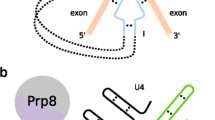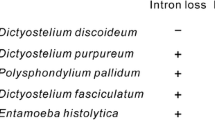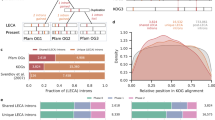Abstract
It has been long debated whether spliceosomal introns originated in the common ancestor of eukaryotes and prokaryotes. In this study, we tested the possibility that extant introns were inherited from the common ancestor of eukaryotes and prokaryotes using in silico simulation. We first identified 21 intron positions that are shared among different families of the P-Type ATPase superfamily, some of which are known to have diverged before the separation of prokaryotes and eukaryotes. Theoretical estimates of the expected number of intron positions shared by different genes suggest that the introns at those 21 positions were inserted independently. There seems to be no intron that arose from before the diversification of the P-Type ATPase superfamily. Namely, the present introns were inserted after the separation of eukaryotes and prokaryotes.




Similar content being viewed by others
References
Kersanach R, Brinkmann H, Liaud M, Zhang D, Martin W, Cerff R (1994) Five identical intron positions in ancient duplicated genes of eubacterial origin. Nature 367:387–389
de Roos A (2007) Conserved intron positions in ancient protein modules. Biol Direct 2:7
Rogozin I, Wolf Y, Sorokin A, Mirkin B, Koonin E (2003) Remarkable interkingdom conservation of intron positions and massive, lineage-specific intron loss and gain in eukaryotic evolution. Curr Biol 13:1512–1517
Nguyen H, Yoshihama M, Kenmochi N (2005) New maximum likelihood estimators for eukaryotic intron evolution. PLoS Comput Biol 1:e79
Rzhetsky A, Ayala F, Hsu L, Chang C, Yoshida A (1997) Exon/intron structure of aldehyde dehydrogenase genes supports the “introns-late” theory. Proc Natl Acad Sci USA 94:6820–6825
de Souza S (2003) The emergence of a synthetic theory of intron evolution. Genetica 118:117–121
Sverdlov A, Csuros M, Rogozin I, Koonin E (2007) A glimpse of a putative pre-intron phase of eukaryotic evolution. Trends Genet 23:105–108
Iwabe N, Kuma K, Kishino H, Hasegawa M, Miyata T (1990) Compartmentalized isozyme genes and the origin of introns. J Mol Evol 31:205–210
Axelsen K, Palmgren M (1998) Evolution of substrate specificities in the P-type ATPase superfamily. J Mol Evol 46:84–101
Okamura H, Denawa M, Ohniwa R, Takeyasu K (2003) P-type ATPase superfamily: evidence for critical roles for kingdom evolution. Ann N Y Acad Sci 986:219–223
Benson D, Karsch-Mizrachi I, Lipman D, Ostell J, Wheeler D (2007) GenBank. Nucleic Acids Res 35:D21–D25
Pruitt K, Tatusova T, Maglott D (2007) NCBI reference sequences (RefSeq): a curated non-redundant sequence database of genomes, transcripts and proteins. Nucleic Acids Res 35:D61–D65
Katoh K, Misawa K, Kuma K, Miyata T (2002) MAFFT: a novel method for rapid multiple sequence alignment based on fast Fourier transform. Nucleic Acids Res 30:3059–3066
Felsenstein J (1989) PHYLIP—phylogeny inference package (Version 3.2). Cladistics 5:164–166
Vingron M, Sibbald P (1993) Weighting in sequence space: a comparison of methods in terms of generalized sequences. Proc Natl Acad Sci USA 90:8777–8781
Higgins D, Thompson J, Gibson T (1996) Using CLUSTAL for multiple sequence alignments. Methods Enzymol 266:383–402
Cho G, Doolittle R (1997) Intron distribution in ancient paralogs supports random insertion and not random loss. J Mol Evol 44:573–584
Roy S, Gilbert W (2005) Rates of intron loss and gain: implications for early eukaryotic evolution. Proc Natl Acad Sci USA 102:5773–5778
Dibb N, Newman A (1989) Evidence that introns arose at proto-splice sites. EMBO J 8:2015–2021
Tomita M, Shimizu N, Brutlag D (1996) Introns and reading frames: correlation between splicing sites and their codon positions. Mol Biol Evol 13:1219–1223
Long M, de Souza S, Rosenberg C, Gilbert W (1998) Relationship between “proto-splice sites” and intron phases: evidence from dicodon analysis. Proc Natl Acad Sci USA 95:219–223
Endo T, Fedorov A, de Souza S, Gilbert W (2002) Do introns favor or avoid regions of amino acid conservation? Mol Biol Evol 19:252–521
Roy S, Nosaka M, de Souza S, Gilbert W (1999) Centripetal modules and ancient introns. Gene 238:85–91
Kaessmann H, Zollner S, Nekrutenko A, Li W (2002) Signatures of domain shuffling in the human genome. Genome Res 12:1642–1650
Long M, Deutsch M (1999) Association of intron phases with conservation at splice site sequences and evolution of spliceosomal introns. Mol Biol Evol 16:1528–1534
Author information
Authors and Affiliations
Corresponding author
Electronic supplementary material
Below is the link to the electronic supplementary material.
Supplemental Data 1
Alignment of amino acids used in this study. Amino acids given in upper-case letters were used under the strict rule, while under the generous rule, amino acids given in upper- and lower-case letters, except for “x”, were used. The letter “x” represents amino acids which were not used in any calculations. (FAS 2540 kb)
Supplemental Table 1
Positions of introns found in the P-Type ATPase genes and the names of genes which have introns at these positions. The first column indicates positions of nucleotides before the introns, and the second column indicates positions of nucleotides after the introns. The third and subsequent columns indicate the names of genes. (XLS 114 kb)
Rights and permissions
About this article
Cite this article
Oda, T., Ohniwa, R.L., Suzuki, Y. et al. Evolutionary dynamics of spliceosomal intron revealed by in silico analyses of the P-Type ATPase superfamily genes. Mol Biol Rep 38, 2285–2293 (2011). https://doi.org/10.1007/s11033-010-0360-3
Received:
Accepted:
Published:
Issue Date:
DOI: https://doi.org/10.1007/s11033-010-0360-3




